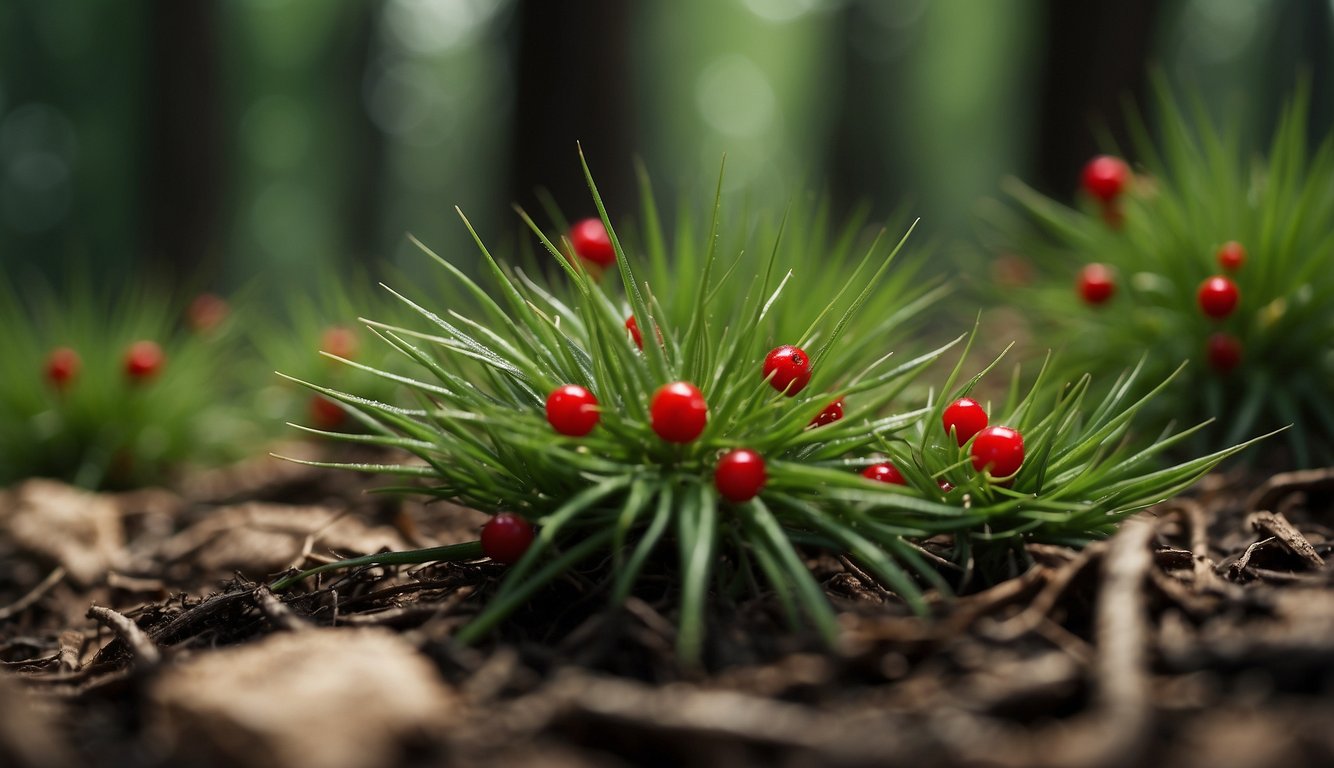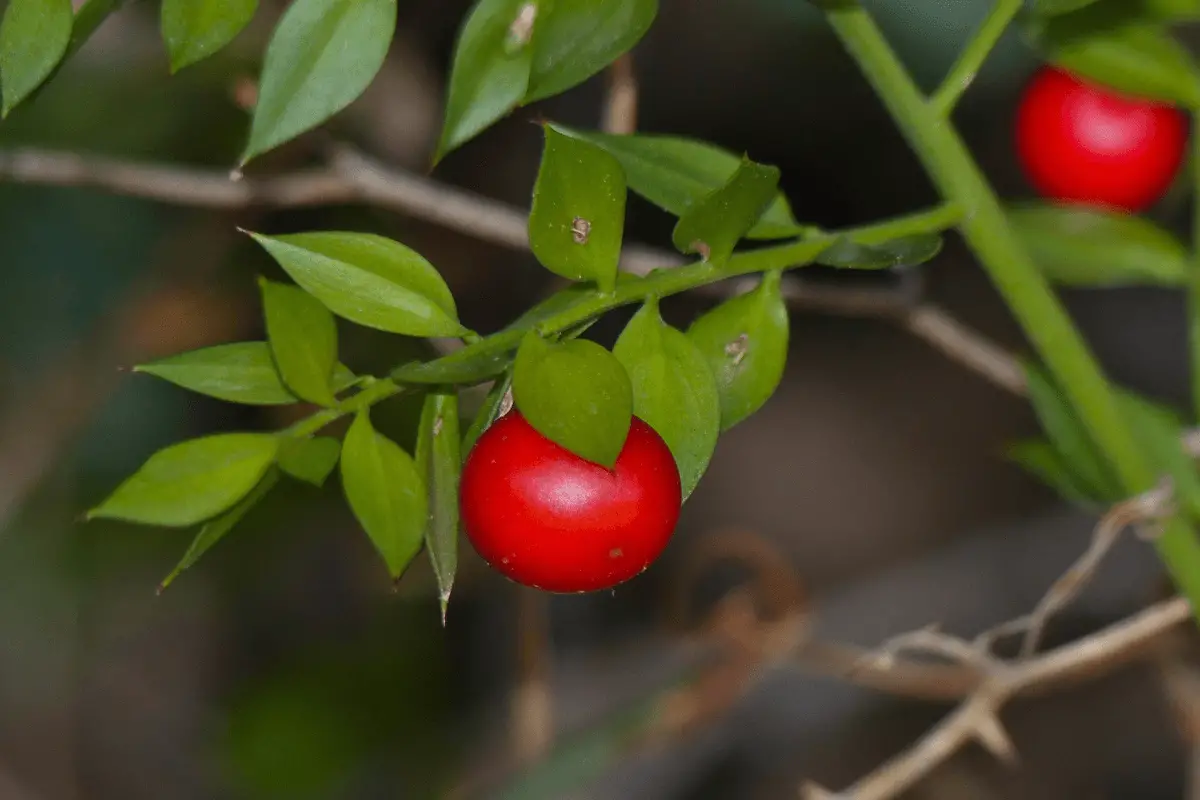Butcher’s Broom, also known as Ruscus aculeatus, is a shrub with centuries of medicinal use. Native to the Mediterranean, it’s a staple in traditional medicine. Used to treat various ailments, this plant is versatile. Known by many names, including knee holly, sweet broom, and box holly.
One of the most common uses of Knee holly is for its ability to improve circulation. The plant contains compounds that can help to strengthen blood vessels and reduce inflammation, making it useful for treating conditions like varicose veins and hemorrhoids. Additionally, Butcher’s Broom has been shown to have anti-inflammatory and diuretic properties, which can help to reduce swelling and fluid retention in the body.
Botanical Profile – Get Your Butcher’s Broom Here.

Common Names
Knee holly (Ruscus aculeatus) is a small evergreen shrub that grows in the Mediterranean region. It is also known as box holly, knee holly, pettigree, and sweet broom.
Plant Characteristics
The plant belongs to the family Asparagaceae and is dioecious, meaning that there are separate male and female plants. The leaves of the Butcher’s Broom are actually flattened stems called cladodes, which give the plant the appearance of having leaves. The cladodes are about 2-3 cm long and 0.2-0.5 cm wide, and have a pointed tip.
The plant produces small greenish flowers in the spring, which are borne singly in the center of the cladodes. The female flowers are followed by a red berry, which contains one or two seeds. The plant also spreads vegetatively through underground rhizomes.
Butcher’s Broom is a hardy plant that can grow in a variety of soil types, including sandy, loamy, and clay soils. It prefers partial to full shade and is often found growing in woodlands, hedgerows, and along roadsides. It is also tolerant of drought, heat, and salt.
Butcher’s Broom (Ruscus aculeatus) is a small evergreen shrub that belongs to the family Asparagaceae. It is dioecious and produces flattened stems called cladodes that give the plant the appearance of having leaves. The plant produces small greenish flowers in the spring and spreads vegetatively through underground rhizomes. It is hardy and can grow in a variety of soil types, and prefers partial to full shade.
Historical Uses – Get Your Butcher’s Broom Here.

As a plant with a long history of use in traditional medicine and other fields, Butcher’s Broom has been utilized for a variety of purposes over the centuries. In this section, I will explore some of the historical uses of this fascinating plant, including its use in traditional medicine, as well as its culinary and other uses.
Traditional Medicine
Butcher’s Broom has been used in traditional medicine for centuries, and it is still used today for a variety of purposes. According to Healthline, this plant has been used to treat a variety of conditions, including hemorrhoids, varicose veins, and circulatory problems. The plant is believed to have anti-inflammatory and vasoconstrictive properties, which may help to reduce swelling and improve circulation.
In addition to its use in treating specific conditions, Butcher’s Broom has also been used as a general tonic for overall health and well-being. According to SpellcraftWisdom, the plant was traditionally used to improve digestion and stimulate the appetite, as well as to treat coughs, colds, and other respiratory problems.
Culinary and Other Uses – Get Your Butcher’s Broom Here.
In addition to its use in traditional medicine, Butcher’s Broom has also been used for a variety of other purposes. According to Britannica, the plant’s tough, flexible stems have been used to make brooms and brushes, while its young shoots have been used as a substitute for asparagus.
Knee holly has also been used in culinary applications. According to Dr. Axe, the plant’s young shoots can be cooked and eaten like asparagus, while its berries can be used to make a type of jam. Additionally, the plant has been used to flavor beer and other alcoholic beverages.
Overall, Butcher’s Broom has a long and fascinating history, with uses ranging from traditional medicine to culinary and other applications. Whether you are interested in exploring the plant’s medicinal properties or simply want to try cooking with its young shoots, there are many ways to incorporate this versatile plant into your life.
Health Benefits and Uses – Get Your Butcher’s Broom Here.
Butcher’s Broom, also known as Ruscus aculeatus, is a plant that has been used for medicinal purposes for centuries. It has several health benefits and uses that have been studied and documented. In this section, I will discuss some of the most significant benefits of Knee holly.
Venous Insufficiency and Circulation
Butcher’s Broom has been found to be effective in treating chronic venous insufficiency, a condition where blood pools in the veins of the legs, causing swelling, pain, and fatigue. Studies have shown that Knee holly can help improve blood circulation and reduce swelling in the legs. It contains compounds that act as anti-inflammatory agents, which can help reduce inflammation and improve circulation.
Anti-Inflammatory Effects
Butcher’s Broom has anti-inflammatory effects that can help reduce swelling and inflammation in the body. It contains compounds that inhibit the production of inflammatory molecules, which can help reduce pain and swelling in conditions such as arthritis, tendonitis, and other inflammatory conditions.
Laxative and Diuretic Properties
Butcher’s Broom has diuretic effects, which means it helps the body get rid of excess fluids. It can be used to treat conditions such as edema, where there is an excess of fluid in the body, causing swelling. Sweet broom also has laxative properties, which can help relieve constipation and promote bowel movements.
Knee holly is a versatile plant that has several health benefits and uses. It can be used to treat conditions such as chronic venous insufficiency, swelling, varicose veins, hemorrhoids, and other inflammatory conditions. It also has diuretic and laxative properties, which can help promote bowel movements and reduce fluid retention.
Active Compounds

As a natural remedy, Butcher’s Broom is believed to contain several active compounds that contribute to its medicinal properties. Among these compounds are saponins and flavonoids.
Saponins and Flavonoids
Saponins are a type of chemical compound found in Butcher’s Broom that are believed to have anti-inflammatory and diuretic properties. They are also thought to help improve circulation by strengthening blood vessels. Some of the specific saponins found in sweet broom include ruscogenin, neoruscogenin, and steroidal saponins. These compounds are believed to help reduce inflammation, relieve pain, and improve blood flow to the legs.
Flavonoids are another type of compound found in Butcher’s Broom that are believed to have antioxidant and anti-inflammatory properties. Some of the specific flavonoids found in Knee holly include hesperidin and rutin. These compounds are believed to help reduce inflammation, improve circulation, and protect against oxidative stress.
Vitamin and Mineral Content
In addition to saponins and flavonoids, Butcher’s Broom is also a rich source of several vitamins and minerals. For example, it contains high levels of ascorbic acid (vitamin C), which is an important antioxidant that helps protect against oxidative stress. It also contains significant amounts of calcium, folic acid, and iron, which are important for maintaining healthy bones, red blood cells, and overall health.
Overall, the active compounds found in Butcher’s Broom are believed to have a range of health benefits, including improving circulation, reducing inflammation, and protecting against oxidative stress. While more research is needed to fully understand the effects of these compounds, sweet broom is a promising natural remedy that may help promote overall health and well-being.
Potential Side Effects

As with any herbal supplement, Butcher’s Broom may cause some side effects. It is important to speak with your healthcare provider before taking this supplement to determine if it is safe for you to use. In this section, I will discuss common adverse reactions, interactions, and contraindications associated with Knee holly.
Common Adverse Reactions
The most common adverse reactions associated with Butcher’s Broom are mild gastrointestinal discomfort, such as upset stomach or nausea. To address these issues, it’s advisable to take Knee holly with food or a full glass of water. In rare cases, sweet broom may cause diarrhea or vomiting.
Interactions and Contraindications
Butcher’s Broom may interact with certain medications, including blood thinners such as warfarin. It is important to speak with your healthcare provider before taking Knee holly if you are taking any medications to avoid potential interactions. Butcher’s Broom may also be contraindicated for individuals with kidney stones, gallstones, or blood clots. Pregnant and breastfeeding women should also avoid using sweet broom as its safety has not been established in these populations.
Knee holly is generally safe to use when taken as directed. However, it may cause mild gastrointestinal discomfort and may interact with certain medications. It is important to speak with your healthcare provider before taking Butcher’s Broom to determine if it is safe for you to use.
Usage and Dosage – Get Your Butcher’s Broom Here.

As with any supplement or herbal remedy, it is important to understand the recommended usage and dosage of Butcher’s Broom. Here are some guidelines to follow when taking this natural remedy.
Supplement Forms – Get Your Butcher’s Broom Here.
Butcher’s Broom is available in several supplement forms, including extracts, capsules, oils, and creams. It is important to choose a reputable brand and follow the manufacturer’s instructions for use.
Recommended Intake
According to Healthline, the recommended dosage of dried Butcher’s Broom root is 1.5-3 grams per day. This dosage has been found to be effective in research studies. However, it is important to note that there is currently no official recommended dose for Knee holly.
Butcher’s Broom is commonly used to improve blood flow in the veins and treat conditions such as chronic venous insufficiency (CVI), heaviness in the legs, and edema. It is often used in combination with other herbal remedies, such as Cyclo 3 Fort, to improve its effectiveness.
When using sweet broom, it is important to start with a low dose and gradually increase it over time. This will help to minimize any potential side effects and ensure that you are getting the maximum benefit from the supplement.
Knee holly is a natural remedy that can be effective in improving blood flow in the veins and treating a variety of conditions. When using this supplement, it is important to choose a reputable brand and follow the recommended dosage guidelines.
Consumer Information – Get Your Butcher’s Broom Here.

As with any natural supplement, it is important to choose a high-quality product when using Butcher’s Broom. When selecting a product, look for a reputable brand that has been approved by the FDA. It is also important to read the label carefully and ensure that the supplement contains the correct dosage of the active ingredient.
Choosing Quality Products – Get Your Butcher’s Broom Here.
When choosing a sweet broom supplement, it is important to look for products that contain the rhizomes of the plant. The rhizomes are the underground stems that contain the active ingredients, such as ruscogenins and neoruscogenins. These compounds are believed to have a number of health benefits, including improving circulation and reducing inflammation.
In addition to looking for products that contain the rhizomes, it is also important to choose a supplement that is free from antinutrients. Antinutrients are compounds that can interfere with the absorption of nutrients in the body, and they can be found in some plant-based supplements. Look for products that have been tested for antinutrient content and are free from these compounds.
Consulting Healthcare Providers
Before taking any new supplement, it is important to consult with a healthcare provider. This is especially important for older adults and those who are taking other medicines, as Butcher’s Broom can interact with certain medications. It is also important to talk to a healthcare provider if you have a history of atherosclerosis or if you are taking medications that affect blood pressure or blood sugar.
Overall, sweet broom is a safe and effective supplement that can provide a number of health benefits. By choosing a high-quality product and consulting with a healthcare provider, you can ensure that you are getting the most out of this natural remedy. For more information on the benefits and side effects of Knee holly, visit WebMD.
Butcher’s Broom and TheHerbProf.com: A Herbal Harmony!

Butcher’s Broom Breakdown: At TheHerbProf.com, we’re all about sweet broom! We delve into its health-boosting properties and its role in herbal medicine.
Herbal Highlights: Learn how Knee holly can enhance your herbal routine. It’s not just a plant; it’s a wellness wonder!
Culinary Creations: Butcher’s Broom in the kitchen? Absolutely! We share innovative recipes that bring out the best in Butcher’s Broom.
Health and Wellness: We’re all about health and wellness, and Butcher’s Broom is a key part of this mission. It’s packed with compounds that promote good health.
Community Connection: Join our community of Knee holly enthusiasts! Share your journey, learn from others, and make some new friends.
So, whether you’re a sweet broom buff or just starting your herbal journey, TheHerbProf.com is your trusty companion. Dive in, explore, and stay healthy!
References:
Little Herb Encyclopedia, by Jack Ritchason; N.D., Woodland Publishing Incorporated, 1995
The Ultimate Healing System, Course Manual, Copyright 1985, Don Lepore
Planetary Herbology, Michael Tierra, C.A., N.D., Lotus Press, 1988
Handbook of Medicinal Herbs, by James A. Duke, Pub. CRP Second Edition 2007
The Complete Medicinal Herbal, by Penelope Ody, Published by Dorling Kindersley
Before You Go – Check the Following Articles!
Frequently Asked Questions – Get Your Butcher’s Broom Here.

What are the medicinal uses of Butcher’s Broom?
Butcher’s Broom has been used for centuries as a traditional medicine to treat a variety of conditions, including poor circulation, swelling, and constipation. It is also commonly used to alleviate symptoms associated with chronic venous insufficiency (CVI), such as leg pain, swelling, and itching. Additionally, Knee holly is believed to have anti-inflammatory and diuretic properties.
Can Butcher’s Broom aid in managing blood pressure levels?
There is some evidence to suggest that Butcher’s Broom may help manage blood pressure levels. Studies have shown that it can help reduce the risk of hypertension and improve blood flow in individuals with CVI. However, more research is needed to determine the effectiveness of Knee holly in managing blood pressure levels.
Are there any benefits of using Butcher’s Broom for skin conditions?
Butcher’s Broom may have some benefits for the skin. It is believed to have anti-inflammatory properties, which can help reduce swelling and redness associated with certain skin conditions, such as eczema and psoriasis. Additionally, Butcher’s Broom may help improve blood flow to the skin, which can promote healing.
What are the potential side effects of consuming Butcher’s Broom?
While Butcher’s Broom is generally considered safe when consumed in recommended doses, it may cause some side effects in some individuals. These can include nausea, stomach upset, and diarrhea. Additionally, Knee holly may interact with certain medications, so it is important to speak with a healthcare provider before consuming it.
How does Butcher’s Broom interact with kidney function?
There is some evidence to suggest that Butcher’s Broom may have a diuretic effect, which can help increase urine output and improve kidney function. However, more research is needed to determine the full extent of Butcher’s Broom’s effects on kidney function.
Is there any evidence supporting Butcher’s Broom as a treatment for erectile dysfunction?
While Butcher’s Broom has been traditionally used to treat erectile dysfunction, there is currently a lack of scientific evidence to support its effectiveness in this area. More research is needed to determine whether Knee holly can be used as a treatment for erectile dysfunction.

